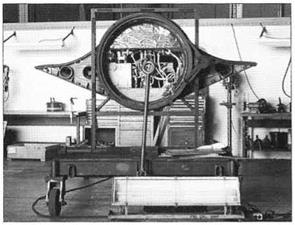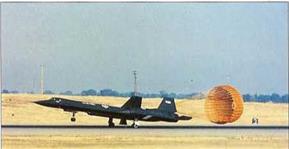Tagboard & Senior Bowl
On 10 October 1962, Kelly Johnson received authorization from the CIA to carry out study work on a drone that would be mated with an A-12. At the root of such a request was the US Government’s decision to discontinue overflight, following political fall-out after the Gary Powers shoot-down. Fourteen days later, Kelly, Ben Rich and Russ Daniell met representatives from Marquardt to discuss ramjet propulsion system options. Progress was rapid, on 7 December a full-scale mock-up of the craft was completed which was referred to within the Skunk Works as the Q-12. Still to receive mission specifications from the Agency, Kelly worked on producing a vehicle with a 3,000 n miles range hauling a Hycon camera system weighing 425 lbs and capable of a photographic
|
|
Top and Above To improve mission flexibility, the SR-71’s nose section is detachable, enabling the aircraft to be fitted with a ground mapping radar unit or a 30 inch Optical Bar Camera (OBC) for horizon-to-horizon panoramic scanning. (Paul Crickmore).
Opposite, top The original nose radar unit, carried by the SR-71, housed a Goodyear PIP which was later replaced by the Loral CAPRE. This was finally replaced by the high resolution Advanced Synthetic Aperture Radar System (ASARSI), built again by Loral. This shot depicts the antenna belonging to the CAPRE system. (Lockheed Martin)
RightThe right aft mission bay compartments Q andT revealed, into which a palletised ‘close-look’ or Technical Objective, TEOC camera can be loaded. (Paul Crickmore)
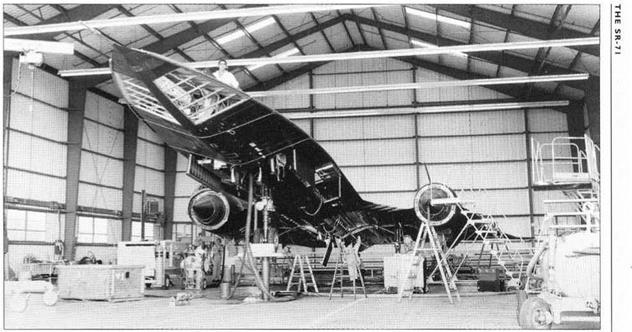 |
resolution of 6 inches from operating altitude. The engine to be used was the Marquardt RJ43 – MA-3 Bomarc, and by October 1963, the overall configuration for the QM2 and its launch platforms – two purpose-built, modified A – 12s – were nearing completion. Code-named ‘Tagboard,’ the designation of both elements was also changed, the carrier vehicle became the ‘M’ – standing for “Mother” – 21 and the 12 became the ‘D – for “Daughter” – 21.
The 11,0001b D-21 was supported on the M-21 by a single, dorsallv mounted pylon. Upon reaching launch point, the mothership’s pilot maintained Mach 3.12 and initiated a 0.9 g push-over. Once released by the Launch Control Officer (LCO), sitting in what was, on other A-12 aircraft, the bay, the D-21 flew its sortie independently. Equipped with a Minneapolis-Honeywcll. inertial navigation system (INS), the D-21 would fly a pre-programmed flight profile, execute turns and camera
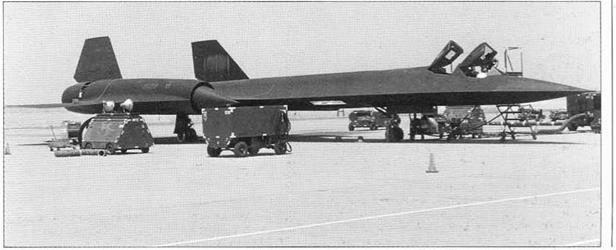 |
on/off points to produce the perfect photo-recce sortie. Having completed its camera run, the drone’s INS system then sent signals to the auto-pilot system to descend to a predetermined ‘feet wet’ film collection point. The entire palletised unit containing INS, camera and film was then ejected at 60,000 ft and Mach 1.67 and parachuted towards the ocean. As the drone continued its descent it was blown apart by a barometrically activated explosive charge. Meanwhile the air retrieval was executed by a JC -130B Hercules. On 12 August 1964, the first M-21 was dispatched to Groom Lake and on 22 December the first D-21/M-21 combination flight took place with Bill Park at the controls. Troubles however dogged Tagboard and it wasn’t until 5 March that the first successful D-21 launch was accomplished. The second launch on 27 April saw the drone reach Mach 3.3, 90,000ft and fly for 1,200 n miles, holding course within half a mile throughout. The
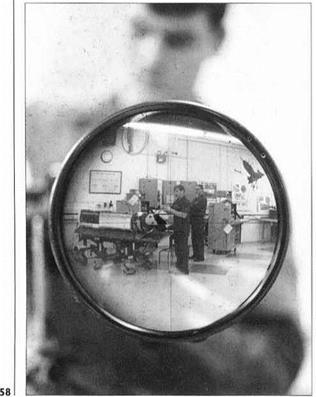

Above A ‘first generation’ example of an enlarged OBC shot, taken by an SR-71 during a state-side training sortie whilst flying at Mach 3 and 80.000ft. Note the white lines delineating car parking spaces. (USAF)
Left An SR-7l’sTEOC, on its pallet, receives some maintenance – the shot was taken through a U-2’s drift-sight. (USAF)
flight came to an end after a hydraulic pump burned out and the D-21 fell out of the sky.
The Air Force remained interested in the drone and on
29 April 1966, a second batch of D-21s were ordered. On 16 June a third successful launch was made and the D-21 flew 1,600 miles, completing all tasks on the flight card except ejecting the all important camera pallet. The fourth and final D-21 sortie from the M-21 occurred on
30 July 1966 and ended in disaster when the drone collided with ‘941 moments after achieving launch separation. The impact caused the mother craft to pitch up so violently that the fuselage forebody broke off. Both Bill Park and his LCO Ray Torick successfully ejected and made a ‘feet wet’ landing, but unfortunately Torick’s pressure suit filled with water and he drowned before he could be rescued. Bill Park spent an hour in the ocean before he was brought aboard a US Navy vessel.
The D-21 was grounded for a year whilst a new launch system was developed. This new operation, code-named Senior Bowl, involved the drone being launched from the
underwing pylons of two modified B-52Hs of the 4200th Test Wing based at Beale AFB. Upon launch the D-21B was accelerated to Mach 3.3 and 80,000ft by a solid propellant rocket developed by Lockheed Propulsion Company of Redlands, California. On achieving cruise speed and altitude the booster was jettisoned and the drone’s flight continued as described earlier. The first launch attempt from a BUFF was made on 6 November 1967; this proved unsuccessful, as did three other attempts. Success was finally achieved on 16 June 1968. Between 9 November 1969 and 20 March 1971, a total of four operational flights over China were attempted. To maintain tight security the B-52, hauling its unique payload, departed Beale at night and lumbered westwards to the Pacific Island of Guam. Just before dawn the next day the flight resumed, the bomber departing Guam and heading for the launch point. Upon vehicle separation, the Buff made its way back to Guam, while the D-21 embarked upon its pre-programmed day-time reconnaissance run. Achieving only limited success, Senior Bowl was cancelled on 15 July 1971.
Senior Crown
![]() Whilst working on Oxcart back in the early spring of 1962, Kelly had mentioned the possibility of producing a reconnaissancc/strikc variant for the Air Force. Lockheed was duly issued with a 90-dav study contract, wherein the various Air Force mission options were identified and defined in terms of the A-12 platform. By the end of April 1962, two different mock-ups were under construction referred to as the R-12 and RS-12. On 18 February
Whilst working on Oxcart back in the early spring of 1962, Kelly had mentioned the possibility of producing a reconnaissancc/strikc variant for the Air Force. Lockheed was duly issued with a 90-dav study contract, wherein the various Air Force mission options were identified and defined in terms of the A-12 platform. By the end of April 1962, two different mock-ups were under construction referred to as the R-12 and RS-12. On 18 February
![]()
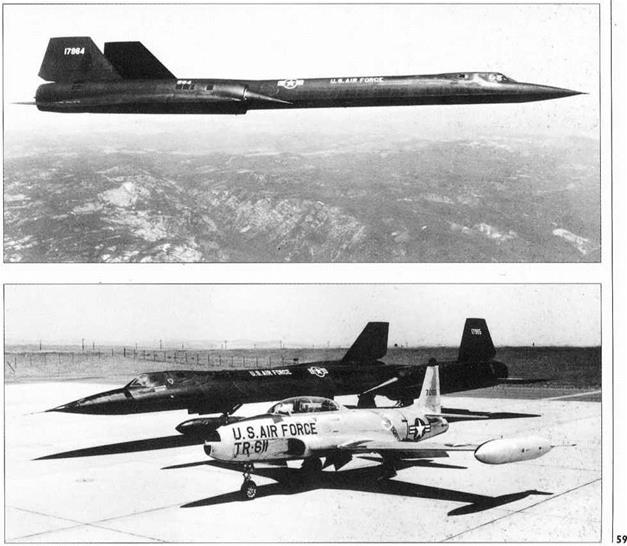 |
Below SR-71A 17964 undertook its first flight on I I May 1966 with Lockheed test pilot Bill Weaver at the controls and Steve Belgau in the back seat. (Lockheed Martin)
Bottom The second 9th SRW aircraft to be lost was 17965, which crashed on 25 October 1967, Pilot, Maj Roy St Martin and his RSO Capt John Carnochan ejected safely. (Lockheed Martin)
![]() 1963, Lockheed received pre-contractual authority to build six aircraft, with the understanding that 25 aircraft would be ordered by 1 July. Col Leo Geary had been the RS-12’s Weapon System Program Officer, but after protracted debate, it was decided that the A-12 project group under Col. Templeton, would inherit the R-12, which became designated SR-71 by the Air Force. The RS-12 and later the B-12/B71 proposals for a strike – version of the aircraft would fail to win production contracts, despite Kelly having demonstrated to the Air Force the unique capabilities of such a platform. This was largely due to the far greater lobbying powers of the XB-70 anil later the l’B-111 fraternity. During a speech made on 24 July 1964, President Johnson revealed to the world the existence of the SR-71.
1963, Lockheed received pre-contractual authority to build six aircraft, with the understanding that 25 aircraft would be ordered by 1 July. Col Leo Geary had been the RS-12’s Weapon System Program Officer, but after protracted debate, it was decided that the A-12 project group under Col. Templeton, would inherit the R-12, which became designated SR-71 by the Air Force. The RS-12 and later the B-12/B71 proposals for a strike – version of the aircraft would fail to win production contracts, despite Kelly having demonstrated to the Air Force the unique capabilities of such a platform. This was largely due to the far greater lobbying powers of the XB-70 anil later the l’B-111 fraternity. During a speech made on 24 July 1964, President Johnson revealed to the world the existence of the SR-71.
In August, Kelly phoned Bob Murphy and asked him if he wanted to work on the SR-71 programme. At the time, Murphy was a superintendent in charge of D-21 drone production. Drone number one was undergoing final check-out while nine others were at various stages of assembly. Bob accepted the offer and was immediately briefed by Kelly: “I want you to go to Palmdale and get site 2 away from Rockwell”. This achieved, the prototype SR-71A, serial 64-17950 (article number 2001), was delivered from Burbank to Site 2, Air Force Plant 42,
Building 210, at Palmdale for final assembly on 29 October, by two large trailers specifically designed for the task. Earlier that y ear, Kelly had promoted the charismat
ic Robert I Gilliland to the position of chief project pilot for the SR-71, a post for which Bob was admirably qualified, having gained a great deal of experience as a member of the F-104 and A-12 test teams.
With two )-58s installed, ‘950 conducted its first engine test run on 18 December 1964. Three days later, a ‘nonflight’ was completed, where Gilliland accelerated the aircraft to 120kts before snapping the throttles back to idle and deploying the large 40-feet drag chute. On 22 December 1964, Gilliland, using his personal callsign ‘Dutch 51’ successfully completed the first flight of an SR-71A in prototy pe 64-17950 – Article 2001 (the significance of this number being that it was the date Kelly
|
|
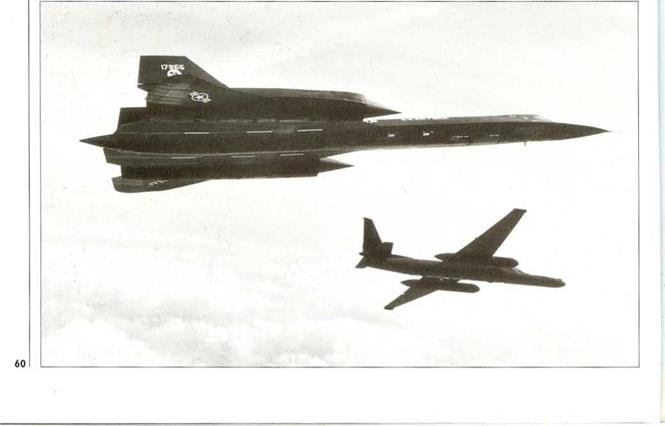
Below SR-71 17955 was operated extensively by Air Force Logistics Command from Plant 42. Palmdale and was dedicated SR-71 test aircraft. It is seen here in company with a U-2R.
(Lockheed Martin)
Above To celebrate America’s Bi-Centennial, several record breaking flights were made by SR-7ls which had a large white cross applied to their underside to assist ground based tracking cameras. Here 17958 returns to earth. (Lockheed Martin)
believed would be reached before the aircraft became vulnerable to interception).
Aircraft 951 and 952 were added to the test fleet for contractor development of payload systems and techniques and shortly after the phase II, Developmental Test Programme was started, four other Lockheed test pilots were brought into the project: Jim Eastham, Bill Weaver, Art Peterson and Darrell Greenamyer.
Developmental efforts within Lockheed were matched b Air Force Systems Command (AFSC) where Col Ben Beilis had been appointed the SR-71 System Programme Officer (SPO). His task was to structure a ‘Development and Evaluation Programme’ that would evaluate the new aircraft for the Air Force, a program undertaken by the SR-71/YF12 Test Force, located at the Air Force Flight Test Centre, Edwards AFB. Both Phase 1 ‘Experimental’ and phase II ‘Development’ test flying had moved to Edwards where SR-71As 953, 954, and 955 were to be used by the ‘blue suiters’. However, the SR-71s were plagued by problems associated with the electrical system, tank sealing and difficulties in obtaining design range.
Whilst these problems were being worked at, Beale AFB, chosen home for the newcomer, had been undergoing an S8.4 million construction program which included the installation of an army of specialised technical support facilities. The 4200th Strategic Reconnaissance Wing was activated at Beale on 1 January 1965 and three months later, four support squadrons were formed. In Januarx 1966, Col Doug Nelson was appointed commander of the new x ing – a job for which he was eminently qualified, having been the Director of Operations for the Oxcart project. Doug began by selecting a small group of highly competent sub-commanders and Strategic Air Command (SAC) fliers to form the initial cadre of the SR-71 unit.
Bottom Due to high airframe temperatures when cruising at Mach 3.2, a special flash resistant fuel was developed. Known as JP-7, normal fuel igniters are unable to generate the heat required to set fuel burning during start-up or when engaging the afterburners. A chemical ignition system (CIS) was therefore developed using Triethylborane (TEB), which ignites with a green flash. (Paul Crickmore)
Below With both ‘burners’ engaged, SR-71 A serial 17960, callsign TRULY55 starts to roll down RAF Mildenhall’s runway.
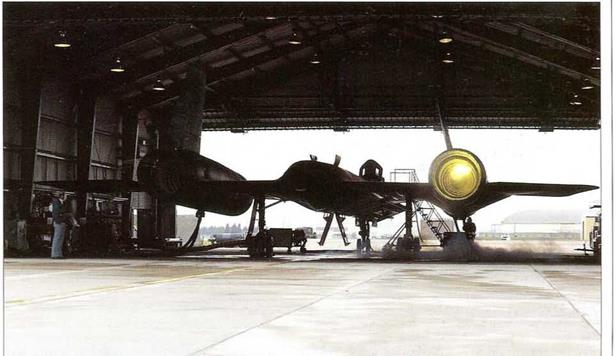 |
(Paul Crickmore)
|
|
![]()
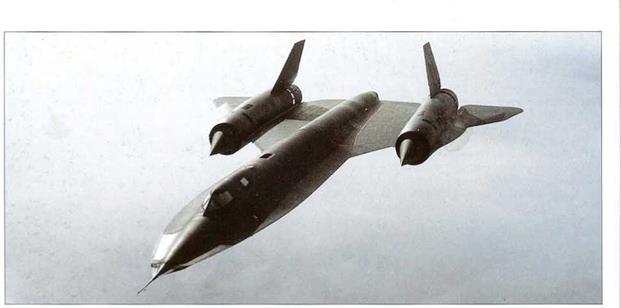 |
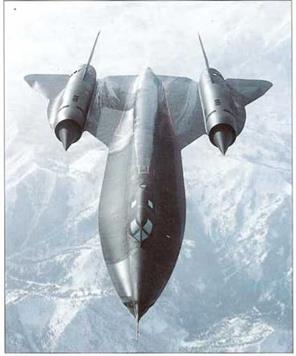 Above Standard operating procedures call for the SR-71 to get airborne with a light fuel load, enabling it to land back immediately should a problem develop. Once airborne, the first order of business is to ‘hook-up’ with the tanker and top-off with fuel.
Above Standard operating procedures call for the SR-71 to get airborne with a light fuel load, enabling it to land back immediately should a problem develop. Once airborne, the first order of business is to ‘hook-up’ with the tanker and top-off with fuel.
(Paul Crickmore)
Right Prior to boom conect, the aircraft establishes itself in the pre-contact position. (Paul Crickmore)
Col Bill Hayes became the deputy commander lor maintenance, Lt Col Ray Haupt, Chief Instructor Pilot, Col Walt W right commanded the Medical Group, Col Clyde Deaniston supervised all category III flight test planning and the flight crews were recruited from the best SAC bomber pilots and navigators in the service.
The first two of eight Northrop T-38 Talons arrived at Beale on 7 July 1965, to be used as ‘companion trainers’ to maintain overall flying proficiency for the SR-71 crew at a fraction of the cost of flying the main aircraft.
On 7 January 1966, Col Doug Nelson and his Chief Instructor, Lt Col Ray Haupt delivered the first SR-7 IB to Beale AFB. Five months later, on 14 April, Nelson and Maj A1 Pennington took delivery of Beale’s first SR – 71A, serial 64-17958. On 25 June 1966, the 4200th was redesignated the 9th Strategic Reconnaissance Wing (SRW) its component flying squadrons being the 1st and 99th Strategic Reconnaissance Squadrons (SRS). Crew training and Category III Operational Testing then proceeded in earnest.











